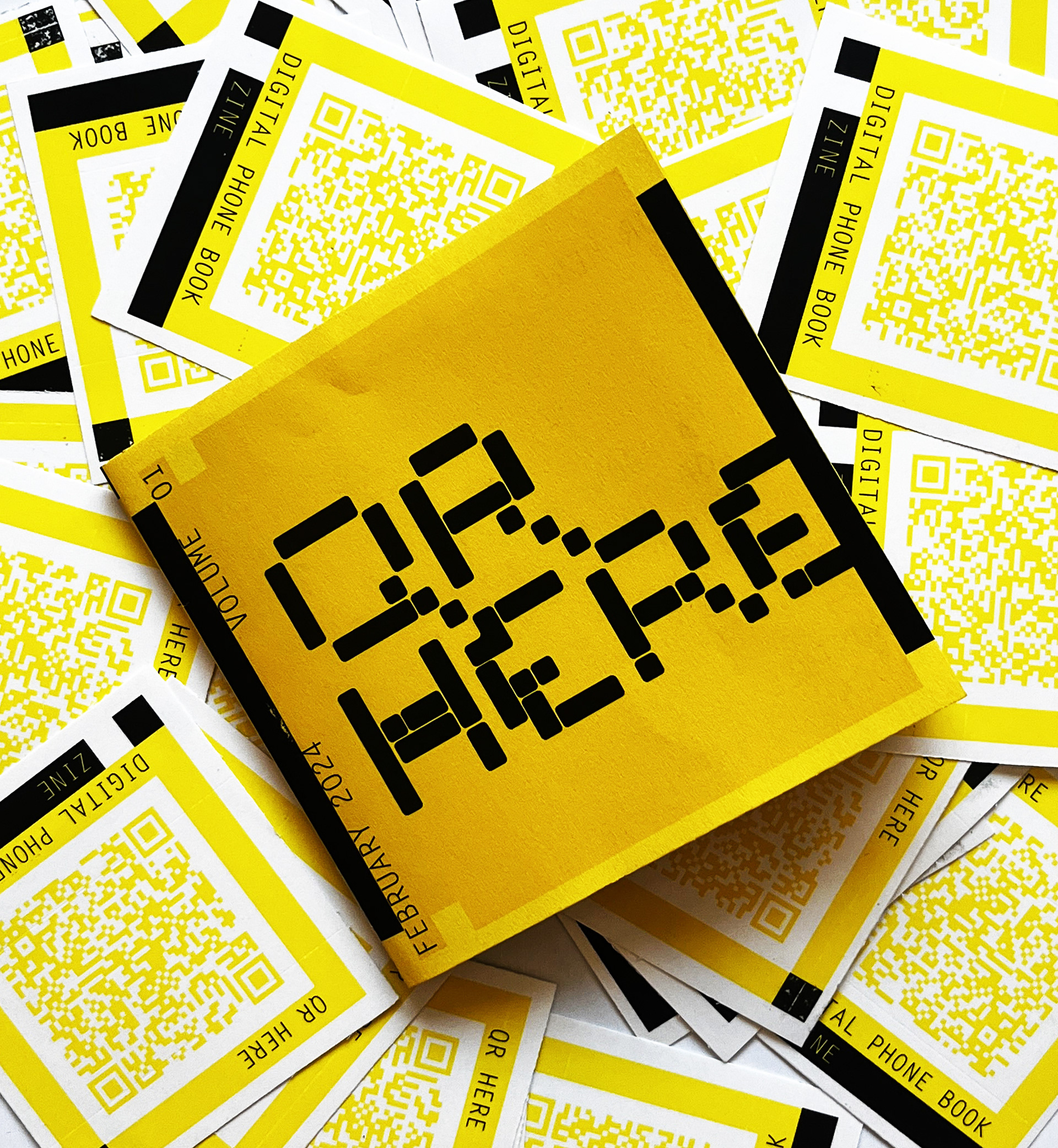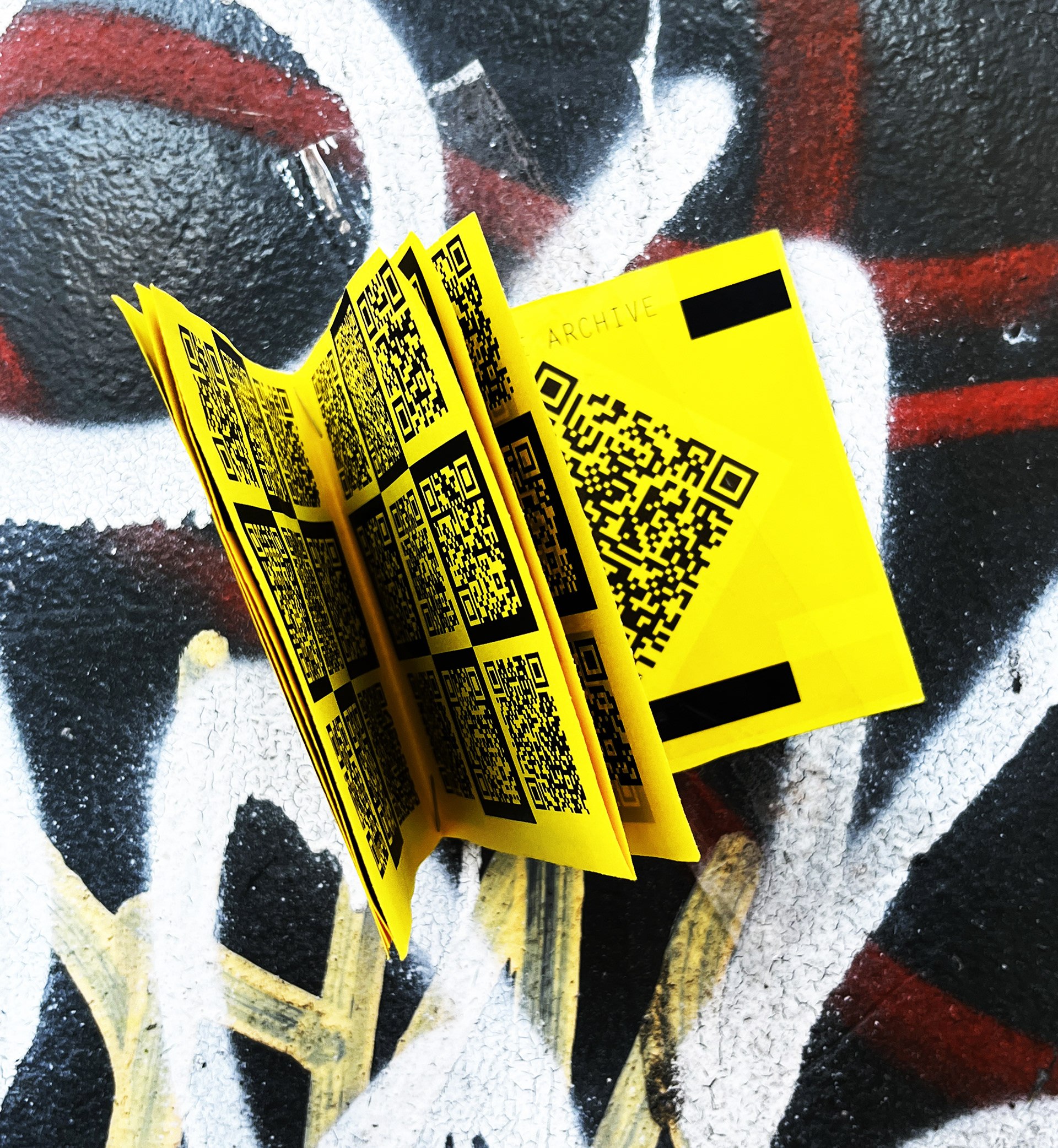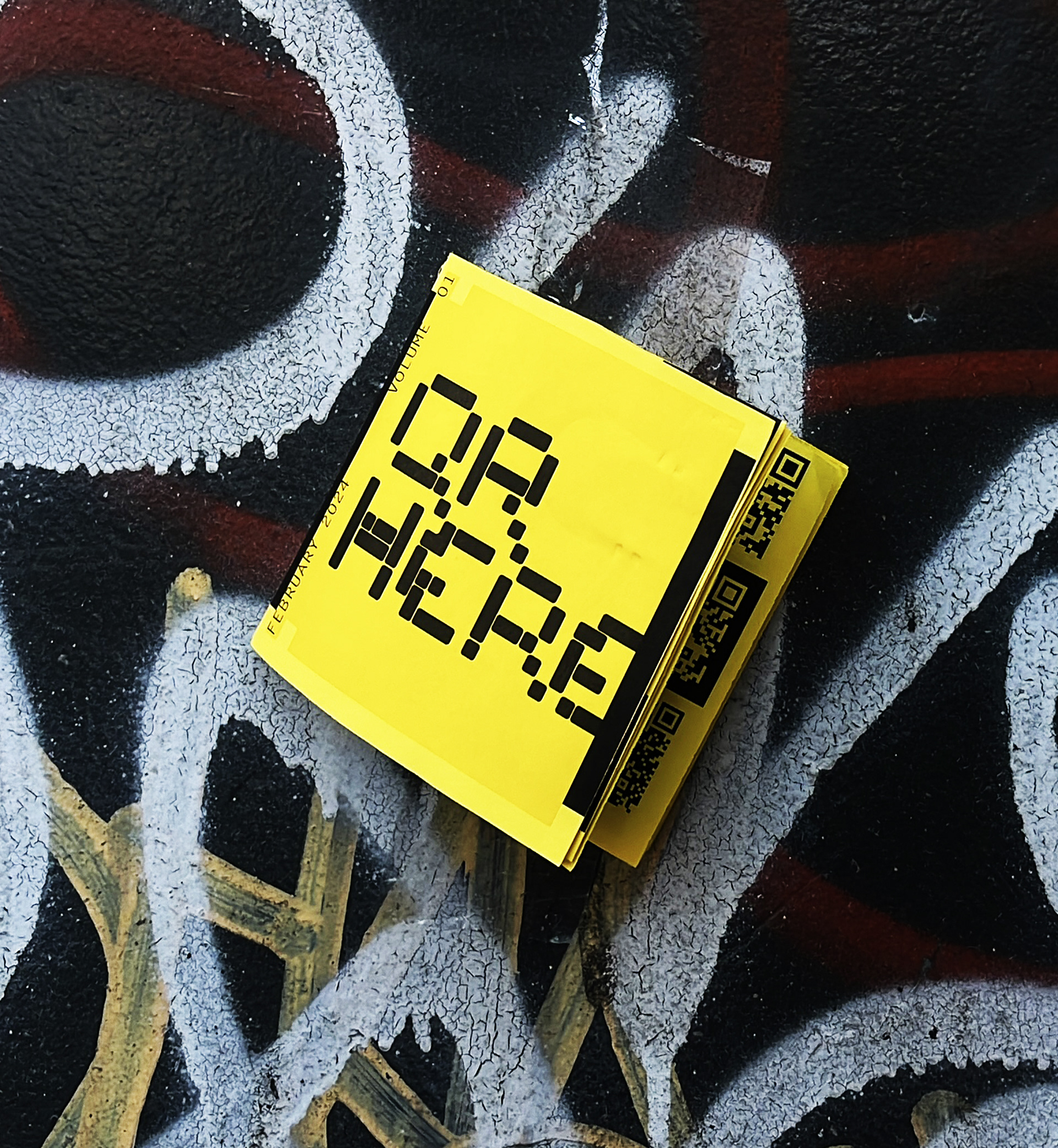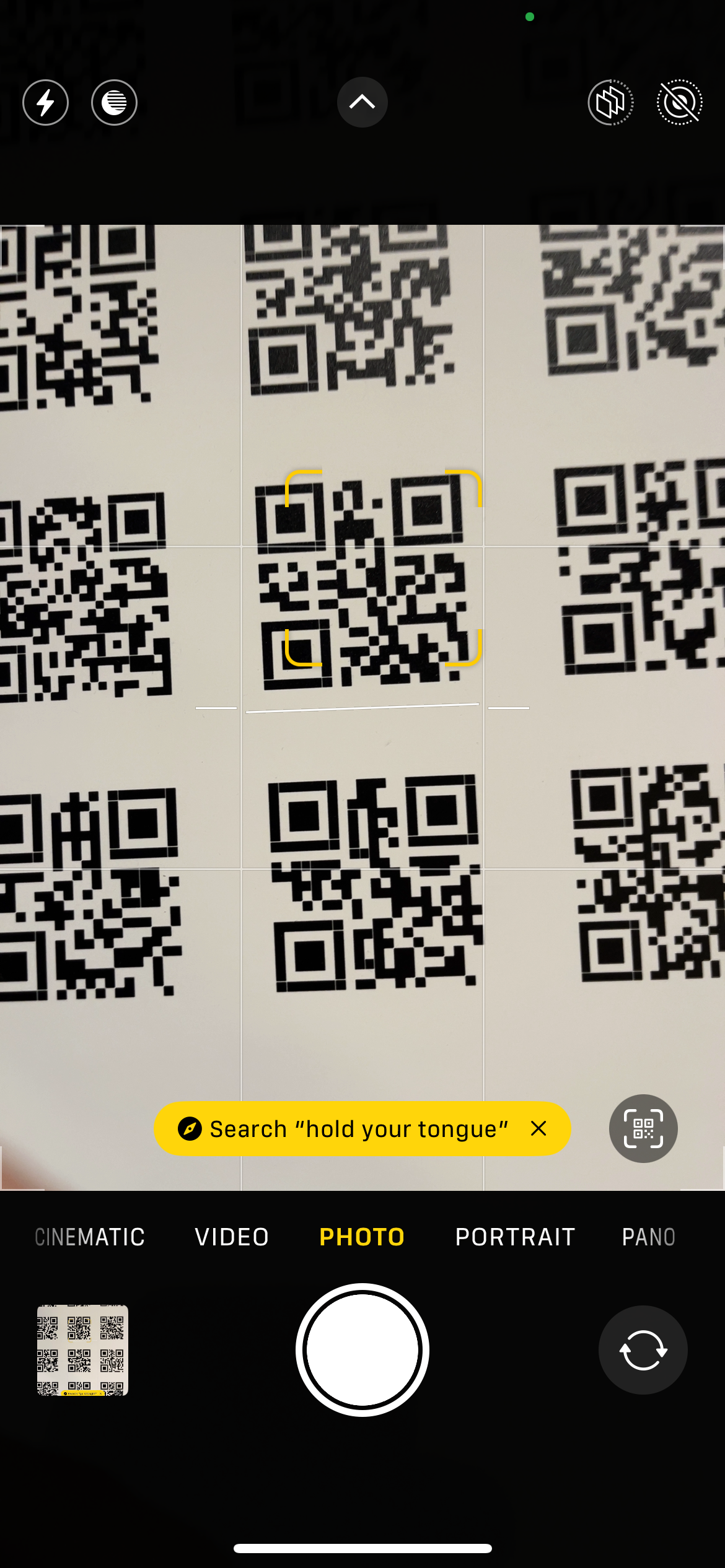The monthly zine project has culminated in a book featuring a year of found QR codes. I handmade a vellum book cover with a stamped title to mimic the temporality of flyers seen on the street that became the source content for my art book.




Have you ever chosen a dentist by a QR code you scanned on the street? Your tattoo artist? Your tutor? This zine tests authenticity with audacity and curiosity.
With so many QR codes, who scans them all? Find out for yourself, and visit the digital sidewalks that I have walked offline. An invisible community made between code, life, and entrepreneurship of strangers – all missing at the moment of discovery, but still present with something to share.
MANIFESTO
QR HERE is a zine project I've created to reflect a modern-day phone book. Over time, the links will break the same way a phone number disconnects.
Some codes hide, and some are too faded or torn to scan, therefore noticed but gone unarchived. Sometimes, your phone battery runs out. You may have no cell service to reach the website at the other end.
QR HERE is a zine project I've created to reflect a modern-day phone book. Over time, the links will break the same way a phone number disconnects.
Some codes hide, and some are too faded or torn to scan, therefore noticed but gone unarchived. Sometimes, your phone battery runs out. You may have no cell service to reach the website at the other end.
If a QR code is placed but nobody scans it, does the digital presence even exist?
Or is the content at the other end of the code ironically distilled into a sequence of squares that only internet-enabled cameras can read? Will humans ever be able to read these codes with just our eyes; will they become a new written language to decode? Or does the advent of tech allow us to forget or ignore the encoded message that a browser's utility provides? Are QR codes similar to a binary code language in that we can understand and decode the placement of 1s and 0s, but with the right technology, why should we have to?
QR codes don’t expire, but both the digital and physical environments they are found in can expire or change. Most code is written purely for technology, and spoken or written language can be shared without technology. QR codes are unique in that they exist in a hybrid communications space being designed by the advent of Web3.
The websites these codes are hard-coded to link to become altered while the internet changes around it. URLs and QR codes are unable to adapt or update on their own. Much like a real image in the world cannot change with us, without a viewer's perception.
The physical environment in which the QR code is placed, hoping to be scanned, changes as well. The content of this zine consists of QR codes that I scanned on street corners, posters, and other public spaces.
This project creates an internet archive made from the happenstance of existing and navigating my "IRL" world. The ongoing volumes of QR HERE reflect the places I have visited and seen during a defined period, and I scan any codes that I have been lucky to notice that were placed there before me, with no other purpose other than something to say. My camera listens.
VOLUME ONE:
The first edition of the QR HERE zine was printed on yellow paper as an homage to the Yellow Pages – named for the colored paper historically found in local phonebooks.






Each printed zine includes a QR code sticker you can place in the world, directing you to a PDF of the zine and its future volumes which I can update remotely from an InDesign cloud file. Think of this as a QR code gateway to hundreds more.
QR HERE: DIGITAL ARCHIVE
An unlabeled sticker leads to a digital master copy of all volumes of the zine. This is the only way you can view all of the QR codes from the project at once.
An unlabeled sticker leads to a digital master copy of all volumes of the zine. This is the only way you can view all of the QR codes from the project at once.
I initially designed a master trackable QR code for the digital zine archive but ultimately felt it didn't speak to the nature of discovery the project was born from: a modern version of searching through phone book pages with what you have already archived in a free, localized reference book.
"YOU ARE HERE"
TITLE DEVELOPMENT + COMMUNITY RESEARCH
The project title, QR HERE is a play on the phrase, "you are here." These codes were each placed by a creator and designer of their own, who produced and stuck them in public spaces they visited to spread a personal message. By scanning a QR code found in the world, you have walked in the steps of the artist or activist before you.
TITLE DEVELOPMENT + COMMUNITY RESEARCH
The project title, QR HERE is a play on the phrase, "you are here." These codes were each placed by a creator and designer of their own, who produced and stuck them in public spaces they visited to spread a personal message. By scanning a QR code found in the world, you have walked in the steps of the artist or activist before you.
The working title for this project was, "LOCAL TO THE INTERNET" – however, I began to notice trends between neighborhoods and QR code content. Some neighborhoods redirected me online to B2C business startups, others peddled black market weed products, and many promotional events, musicians, and artists were popular near creative venues. At first glance, a QR code does not indicate the local content behind it, and thus all are created equal aside from any additional branding; yet each holds the power to direct to an infinite diversity of content and topics.


LOGOTYPE ARTWORK PROCESS
Drawn by hand on gridded paper; later adapted to a gridded layout in Adobe Illustrator.
Drawn by hand on gridded paper; later adapted to a gridded layout in Adobe Illustrator.


PRODUCTION
I spent $150 and 3 hours printing and assembling 50 copies at FedEx.
I spent $150 and 3 hours printing and assembling 50 copies at FedEx.
ACKNOWLEDGEMENTS
The research and intention behind this self-produced project were inspired by the Brooklyn Museum's "Copy Machine Manifestos: Artists Who Make Zines" exhibition.
The research and intention behind this self-produced project were inspired by the Brooklyn Museum's "Copy Machine Manifestos: Artists Who Make Zines" exhibition.
Of course, I had to drop off my own.
"This is the first exhibition dedicated to the rich history of five decades of artists’ zines produced in North America. Since the 1970s, zines—short for “fanzines,” magazines, or self-published booklets of texts and images, usually made with a copy machine—have given a voice and visibility to many operating outside of mainstream culture. The exhibition includes over 800 images of zines and works in other media alongside texts by the curators." –Brooklyn Museum, 2024
My multidisciplinary design studio.




I was also inspired by the QR_HOBO_CODES project designed by The Free Art And Technology Lab that was featured as part of Cooper Hewitt's Give Me a Sign: The Language of Symbols exhibit. The project features open-source design assets created by a javascript platform the lab created that generates text-first search links that discretely indicate nearby public resources for nomads and those struggling with homelessness. This QR code medium is a modernized version of the network of hidden illustrations that reflects the language of symbols 19th-century vagabond travelers used to warn, help, or redirect others based on their own experiences in the area.
"These stencils can be understood as a covert markup scheme for urban spaces — providing directions, information, and warnings to digital nomads and other indigenterati. We present these as modern equivalents of the chalk-based "hobo signs" developed by 19th-century vagabonds and migratory workers to cope with the difficulty of nomadic life." –The Free Art And Technology Lab, 2019
"Give Me a Sign: The Language of Symbols examines the fascinating histories behind many of the symbols that instruct, protect, entertain, empower, and connect people. As important communication tools in our daily lives, symbols are constantly evolving based on new needs and users. They formed some of the first written human expressions and today animate our digital chats." –Cooper Hewitt, 2024







LEGAL / INQUIRIES
Advertising opportunities for your business within this zine project are accepted on a case-by-case basis. The opinions and/or content of the website featured in any QR HERE content do not directly reflect those of the curator (me).
Advertising opportunities for your business within this zine project are accepted on a case-by-case basis. The opinions and/or content of the website featured in any QR HERE content do not directly reflect those of the curator (me).










